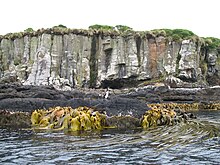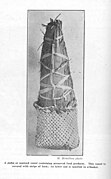Durvillaea
| Durvillaea | |
|---|---|

| |
| D. poha and D. antarctica at Brighton Beach, Otago | |
| Scientific classification | |
| Domain: | Eukaryota |
| Clade: | Diaphoretickes |
| Clade: | SAR |
| Clade: | Stramenopiles |
| Phylum: | Gyrista |
| Subphylum: | Ochrophytina |
| Class: | Phaeophyceae |
| Order: | Fucales |
| Family: | Durvillaeaceae (Oltmanns) De Toni |
| Genus: | Durvillaea Bory |
| Type species | |
| D. antarctica | |
| Species | |
|
See text | |
Durvillaea is a genus of brown algae in the monotypic family Durvillaeaceae. All members of the genus are found in the southern hemisphere, particularly New Zealand, South America, Australia and various subantarctic islands.[3]
Common name and etymology
The common name for Durvillaea is southern bull kelp, although this is often shortened to bull kelp, which can generate confusion with the North Pacific kelp species Nereocystis luetkeana.[4][5]
The genus is named after French explorer Jules Dumont d'Urville (1790-1842).[6]
Description

Durvillaea species are characterised by their prolific growth and plastic morphology.[7]
Two species, D. antarctica and D. poha are buoyant due to a honeycomb-like structure in the fronds of the kelp that holds air.[3][8] When these species detach from the seabed, this buoyancy allows for plants to drift for substantial distances, permitting long distance dispersal.[3][9] In contrast, species as D. willana lack such 'honeycomb' tissue and are non-buoyant, preventing the plants from moving long distances.[9]
Ecology

Durvillaea bull kelp grow within intertidal and shallow subtidal areas, typically on rocky wave-exposed coastal sites.[7] Species can withstand a high level of disturbance from wave action,[7] although storms can remove plants from substrates.[10][11][12]
Epifauna and rafting
Holdfasts of D. antarctica and other species are often inhabited by a diverse array of epifaunal invertebrates, many of which burrow into and graze on the kelp. In New Zealand, epifaunal species include the sea-star Anasterias suteri, crustaceans Parawaldeckia kidderi, P. karaka, Limnoria segnis and Limnoria stephenseni, and the molluscs Cantharidus roseus, Onchidella marginata, Onithochiton neglectus, and Sypharochiton sinclairi.[10][11][12]
Specimens of Durvillaea can detach from substrates, particularly during storms. Once detached, buoyant species such as D. antarctica and D. poha can float as rafts, and can travel vast distances at sea, driven by ocean currents. Kelp-associated invertebrates can be transported inside of drifting kelp holdfasts, potentially leading to long-distance dispersal and a significant impact upon the population genetic structure of the invertebrate species.[10][11][12]
Environmental stressors

Increased temperatures and heatwaves, increased sedimentation, and invasive species (such as Undaria pinnatifida) are sources of physiological stress and disturbance for members of the genus.[13]
A marine heatwave in the summer of 2017/18 appears to have caused the local extinction of multiple Durvillaea species at Pile Bay, on the Banks Peninsula.[14] Once the kelp was extirpated, the invasive kelp Undaria pinnatifida recruited in high densities.[14]
Disturbance from earthquake uplift
Earthquake uplift that raises the intertidal zone by as little as 1.5 metres can cause Durvillaea bull kelp to die off in large numbers.[9][15][16] Increased sedimentation following landslides caused by earthquakes is also detrimental.[15][16] Once an area is cleared of Durvillaea following an uplift event, the bull kelp that re-colonises the area can potentially originate from genetically distinct populations far outside the uplift zone, spread via long distance-dispersal.[17]
This notably occurred along the Kaikōura coastline following the 2016 Kaikoura earthquake, which caused uplift up to 6 metres.[15][16][17] The loss of Durvillaea kelp caused ecological disturbance, significantly affecting the biodiversity of the local intertidal community.[15][16] Genetic analysis indicated that some of the Durvillaea that subsequently reached the affected coastline came from areas >1,200 kilometres away.[17]
Phylogeographic analysis of D. antarctica indicates that a historic uplift event (800 - 1400 years before present) along the Akatore fault zone and subsequent recolonisation, has left a lasting impact upon the genetic diversity of the species.[18] Such a genetic impact may support the founder takes all hypothesis.[18]
Gaps in the current geographic range of D. willana may have been caused by local extinction following historic earthquake uplift events such as the 1855 Wairarapa earthquake.[9]
Species and distribution
There are currently eight recognised species within the genus, and the type species is D. antarctica.[1] All species are restricted to the Southern Hemisphere and many taxa are endemic to particular coastlines or subantarctic islands.
- Durvillaea amatheiae X.A. Weber, G.J. Edgar, S.C. Banks, J.M. Waters & C.I. Fraser, 2017,[19] endemic to southeast Australia.[3][19]
- Durvillaea antarctica (Chamisso) Hariot,[1] found in New Zealand, Chile and various subantarctic islands including Macquarie Island.[2][3][5][7][8][18][20][21]
- Durvillaea chathamensis C.H.Hay, 1979,[21] endemic to the Chatham Islands.[3][5]
- Durvillaea fenestrata C. Hay, 2019,[3] endemic in the subantarctic Antipodes Islands.[3][5]
- Durvillaea incurvata (Suhr) Macaya,[3] endemic to Chile.[3]
- Durvillaea poha C.I. Fraser, H.G. Spencer & J.M. Waters, 2012,[8] endemic to South Island of New Zealand, as well as the subantarctic Snares and Auckland Islands.[3][5][8][20]
- Durvillaea potatorum (Labillardière) Areschoug, endemic to southeast Australia.[4][5][22]
- Durvillaea willana Lindauer, 1949,[23] endemic to New Zealand.[3][5][9][21][23]
Evolution
A time-calibrated phylogeny of Durvillaea based on four mitochondrial and nuclear DNA markers (COI, rbcL, 28S and 18S) indicates the evolutionary relationships shown in the cladogram below.[3][5] Notably, additional unclassified lineages were estimated within D. antarctica.[3][5]
|
Use of Durvillaea species
In New Zealand, Māori use D. antarctica (rimurapa) and D. poha to make pōhā bags, which are used to transport food and fresh water, to propagate live shellfish, and to make clothing and equipment for sports.[24][25][26] Pōhā are especially associated with Ngāi Tahu and are often used to carry and store muttonbird (tītī) chicks.[24][25] D. antarctica and D. incurvata have been used in Chilean cuisine for salads and stews, predominantly by the Mapuche indigenous people who refer to it as collofe or kollof.[3][27] The same species is also called cochayuyo (cocha: lake, and yuyo: weed), and hulte in Quechua.[3] In Australia, D. potatorum is collected as beach wrack from King Island, where it is then dried as chips and sent to Scotland for phycocolloid extraction.[28] Tasmanian aborigines used bags made from D. potatorum to transport freshwater.
-
Cochayuyo (D. antarctica) for sale in Chile
References
- ^ a b c Bory de Saint-Vincent, J.B.G.M. (1826). Laminaire, Laminaria. In: Dictionnaire Classique d'Histoire Naturelle. (Audouin, I. et al. Eds) Vol. 9, pp. 187-194.
- ^ a b Dufour, C; Probert, PK; Savage, C (2012). "Macrofaunal colonisation of stranded Durvillaea antarctica on a southern New Zealand exposed sandy beach". New Zealand Journal of Marine and Freshwater Research. 46 (3): 369–383. doi:10.1080/00288330.2012.676557.
- ^ a b c d e f g h i j k l m n o p q Fraser, Ceridwen I.; Velásquez, Marcel; Nelson, Wendy A.; Macaya, Erasmo C.A.; Hay, Cameron (2019). "The biogeographic importance of buoyancy in macroalgae: a case study of the southern bull‐kelp genus Durvillaea (Phaeophyceae), including descriptions of two new species". Journal of Phycology. 56 (1): 23–36. doi:10.1111/jpy.12939. PMID 31642057.
- ^ a b Cheshire, A.C.; Hallam, N. (2009). "Morphological Differences in the Southern Bull-Kelp (Durvillaea potatorum) throughout South-Eastern Australia". Botanica Marina. 32 (3): 191–198. doi:10.1515/botm.1989.32.3.191. S2CID 83670142.
- ^ a b c d e f g h i Fraser, C.I.; Winter, D.J.; Spencer, H.G.; Waters, J.M. (2010). "Multigene phylogeny of the southern bull-kelp genus Durvillaea (Phaeophyceae: Fucales)". Molecular Phylogenetics and Evolution. 57 (3): 1301–11. doi:10.1016/j.ympev.2010.10.011. PMID 20971197.
- ^ M. Huisman, John (2000). Marine Plants of Australia. University of Western Australia Press. p. 212. ISBN 978-1-876268-33-6.
- ^ a b c d "Kelp". Australian Antarctic Division: Leading Australia’s Antarctic Program. Department of the Environment and Energy. Retrieved 7 December 2016.
- ^ a b c d Fraser, Ceridwen I.; Spencer, Hamish G.; Waters, Jonathan M. (2012). "Durvillaea poha sp. nov. (Fucales, Phaeophyceae): a buoyant southern bull-kelp species endemic to New Zealand". Phycologia. 51 (2): 151–156. doi:10.2216/11-47.1. S2CID 86386681.
- ^ a b c d e Hay, Cameron H. (2019). "Seashore uplift and the distribution of the bull kelp Durvillaea willana Lindauer in New Zealand". New Zealand Journal of Botany. 2019 (2): 94–117. doi:10.1080/0028825X.2019.1679842.
- ^ a b c Nikula, Raisa; Fraser, Ceridwen I.; Spencer, Hamish G.; Waters, Jonathan M. (2010). "Circumpolar dispersal by rafting in two subantarctic kelp-dwelling crustaceans". Marine Ecology Progress Series. 405: 221–230. Bibcode:2010MEPS..405..221N. doi:10.3354/meps08523.
- ^ a b c Nikula, Raisa; Spencer, Hamish G.; Waters, Jonathan M. (2013). "Passive rafting is a powerful driver of transoceanic gene flow". Biology Letters. 9 (1): 20120821. doi:10.1098/rsbl.2012.0821. PMC 3565489. PMID 23134782.
- ^ a b c Waters, Jonathan M.; King, Tania M.; Fraser, Ceridwen I.; Craw, Dave (2018). "An integrated ecological, genetic and geological assessment of long-distance dispersal by invertebrates on kelp rafts". Frontiers of Biogeography. 10 (3/4): e40888. doi:10.21425/F5FBG40888.
- ^ Thomsen, Mads S.; Mondardini, Luca; Alestra, Tommaso; Gerrity, Shawn; Tait, Leigh; South, Paul M.; Lilley, Stacie A.; Schiel, David R. (2019). "Local Extinction of Bull Kelp (Durvillaea spp.) Due to a Marine Heatwave". Frontiers in Marine Science. 6. doi:10.3389/fmars.2019.00084.
- ^ a b Thomsen, Mads S.; South, Paul M. (2019). "Communities and Attachment Networks Associated with Primary, Secondary and Alternative Foundation Species; A Case Study of Stressed and Disturbed Stands of Southern Bull Kelp". Diversity. 11 (4): 56. doi:10.3390/d11040056.
- ^ a b c d Schiel, David R.; Alestra, Tommaso; Gerrity, Shawn; Orchard, Shane; Dunmore, Robyn; Pirker, John; Lilley, Stacie; Tait, Leigh; Hickford, Michael; Thomsen, Mads (2019). "The Kaikōura earthquake in southern New Zealand: Loss of connectivity of marine communities and the necessity of a cross‐ecosystem perspective". Aquatic Conservation. 29 (9): 1520–1534. doi:10.1002/aqc.3122.
- ^ a b c d "Kelp forests after the Kaikōura Earthquake". Science Learning Hub. 23 January 2020. Retrieved 21 February 2020.
- ^ a b c Peters, Jonette C.; Waters, Jonathan M.; Dutoit, Ludovic; Fraser, Ceridwen I. (2020). "SNP analyses reveal a diverse pool of potential colonists to earthquake-uplifted coastlines". Molecular Ecology. 29 (1): 149–159. doi:10.1111/mec.15303. PMID 31711270.
- ^ a b c Parvizi, Elahe; Craw, Dave; Waters, Jonathan M. (2019). "Kelp DNA records late Holocene paleoseismic uplift of coastline, southeastern New Zealand". Earth and Planetary Science Letters. 520: 18–25. Bibcode:2019E&PSL.520...18P. doi:10.1016/j.epsl.2019.05.034.
- ^ a b Weber, X.A., Edgar, G.J., Banks, S.C., Waters, J.M., and Fraser, C.I. "A morphological and phylogenetic investigation into divergence among sympatric Australian southern bull kelps (Durvillaea potatorum and D. amatheiae sp. nov.)." Mol. Phylogenet. Evol. (2017) 107:630-643.
- ^ a b Fraser, Ceridwen I.; Hay, Cameron H.; Spencer, Hamish G.; Waters, Jonathan M. (2009). "Genetic and morphological analyses of the southern bull kelp Durvillaea antarctica (Phaeophyceae: Durvillaeales) in New Zealand reveal cryptic species". Journal of Phycology. 45 (2): 436–443. doi:10.1111/j.1529-8817.2009.00658.x. PMID 27033822.
- ^ a b c Cameron H., Hay (1979). "Nomenclature and taxonomy within the genus Durvillaea Bory (Phaeophyceae: Durvilleales Petrov)". Phycologia. 18 (3): 191–202. doi:10.2216/i0031-8884-18-3-191.1.
- ^ Cheshire, Anthony C.; Hallam, Neil D. (1985). "The environmental role of alginates in Durvillaea potatorum (Fucales, Phaeophyta)". Phycologia. 24 (2): 147–153. doi:10.2216/i0031-8884-24-2-147.1.
- ^ a b Lindauer, V.W. (1949). "Notes on marine algae of New Zealand. I". Pacific Science. 3: 340–352.
- ^ a b "Page 4. Traditional use of seaweeds". Te Ara: The Encyclopedia of New Zealand. 12 Jun 2006. Retrieved 19 November 2019.
- ^ a b "Traditional Māori food gathering". Museum of New Zealand Te Papa Tongarewa. Retrieved 21 November 2019.
- ^ "Maori shellfish project wins scholarship". SunLive. 13 May 2018. Retrieved 26 November 2019.
- ^ Stuart, Jim (15 April 2010). "Seaweed: Cochayuyo and Luche". Eating Chilean.
- ^ Kelp Industries (August 2004). "Proposal for the harvest and export of native flora under the Environment Protection and Biodiversity Conservation Act 1999" (PDF).
Further reading
- Adams, N.M. (1994). Seaweeds of New Zealand. Canterbury University Press. ISBN 978-0908812219.
- Morton, J.W.; Miller, M.C. (1973). The New Zealand Seashore. Collins.


